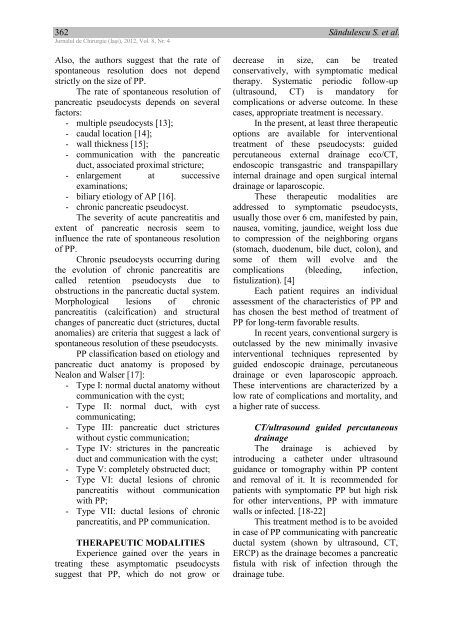Pancreatic pseudocyst 361<strong>Jurnalul</strong> <strong>de</strong> <strong>Chirurgie</strong> (Iaşi), 2012, Vol. 8, Nr. 4Ten patients (21.7%) were submittedto endoscopic drainage as follows: 2transpapillary drainage, 5 and 3transduo<strong>de</strong>nal and transgastric drainage,respectively. Endoscopic drainage waseffective in <strong>de</strong>creasing the size of PP leaksthrough the stent placed insi<strong>de</strong> the cyst. Tothe other 6 patients endoscopic approachwas tempted but it failed for differentreasons: technical, collateral circulation,inhomogeneous content, thick wall,significant bleeding at puncture site. Onepatient required emergency surgery due tohemorrhage.Surgical procedures were performed in8 patients (17.39%): 4 cysto -gastrostomy, 3cysto-jejunostomy and 3 external drainages(2 patients with double localization of PP).We have noted a complication aftercysto-jejunostomy: upper gastrointestinalbleeding at 6th postoperative day because ofan erosion of the splenic artery insi<strong>de</strong> the PP.It was diagnosed by angiography and nee<strong>de</strong>dsurgical re-intervention for hemostasis.In other 2 patients who haveun<strong>de</strong>rgone external drainage of PP(immature wall not a<strong>de</strong>quate foranastomosis) a pancreatic fistula followedwith prolonged external drainage (50 and 62days respectively.The postoperative course wasuneventful for the other patients.DISCUSSIONSAccording to Atlanta classification [1],there are 4 distinct concepts that <strong>de</strong>finepancreatic collections:- acute fluid collections occurring earlyin evolution of PA, without well<strong>de</strong>finedwall;- acute pancreatic pseudocyst, which is awell established wall of granulationtissue and fibrosis, which occurs in 4-6weeks after the onset of PA;- chronic pseudocyst occurring in theevolution of chronic pancreatitis;- pancreatic abscess, infection occurringthrough one of the three collections.Recently <strong>de</strong>scribed, a new entity in theclassification of pancreatic collections,namely “walled-off pancreatic necrosis” [2]tends to replace the term pancreatic abscessor infected pancreatic collection, either focalpancreatic necrosis or pancreatic pseudocyst.An acute pancreatic pseudocyst is<strong>de</strong>fined as a fluid collection containingpancreatic juice, <strong>de</strong>limited by a fibrous wallof granulation tissue without epitheliumconsequence of acute pancreatitis orpancreatic trauma. Chronic pancreaticpseudocyst is a fluid collection of pancreaticjuice enclosed by a wall and fibrousgranulation tissue that occurs in the<strong>de</strong>velopment of chronic pancreatitis in theabsence of an episo<strong>de</strong> of acute pancreatitis.In general, acute and chronic pseudocystshave a different natural history, althoughmany studies do not distinguish acute fromchronic pseudocyst.Acute pseudocysts following anepiso<strong>de</strong> of acute pancreatitis are calledpostinflammatory/postnecrotic pseudocystsas it further <strong>de</strong>velops pancreatic necrosis an<strong>de</strong>xtravasations of pancreatic juice. Theycontain pancreatic enzymes and <strong>de</strong>velop atmore than 4 weeks from the episo<strong>de</strong> ofsevere acute pancreatitis, a necessary timefor maturation of the pseudocyst wall andappearance of granulation tissue. This acutepancreatic pseudocyst and pancreaticnecrosis are differentiated pancreatic fluidcollections occurring early in the evolutionof acute pancreatitis. All patients with theacute pancreatic pseudocyst and pancreaticnecrosis areas [3], but not all patients withpancreatic or peripancreatic necrosis willsubsequently <strong>de</strong>velop pancreatic pseudocyst[4].Pancreatic pseudocysts that thisevolution in size over 6 cm, persists morethan 4 weeks are symptomatic, have a highrisk of complications: infection,compression, rupture into the peritoneum orhollow organs, bleeding. In the literatureindicated that spontaneous resolution ofpseudocyst varies between 8 and 70% ofpatients [5-11].The pancreatic pseudocyst persists formore than 6 weeks episo<strong>de</strong> of PA with thespontaneous resolution rate <strong>de</strong>creases [12].
362 Săndulescu S. et al.<strong>Jurnalul</strong> <strong>de</strong> <strong>Chirurgie</strong> (Iaşi), 2012, Vol. 8, Nr. 4Also, the authors suggest that the rate ofspontaneous resolution does not <strong>de</strong>pendstrictly on the size of PP.The rate of spontaneous resolution ofpancreatic pseudocysts <strong>de</strong>pends on severalfactors:- multiple pseudocysts [13];- caudal location [14];- wall thickness [15];- communication with the pancreaticduct, associated proximal stricture;- enlargement at successiveexaminations;- biliary etiology of AP [16].- chronic pancreatic pseudocyst.The severity of acute pancreatitis an<strong>de</strong>xtent of pancreatic necrosis seem toinfluence the rate of spontaneous resolutionof PP.Chronic pseudocysts occurring duringthe evolution of chronic pancreatitis arecalled retention pseudocysts due toobstructions in the pancreatic ductal system.Morphological lesions of chronicpancreatitis (calcification) and structuralchanges of pancreatic duct (strictures, ductalanomalies) are criteria that suggest a lack ofspontaneous resolution of these pseudocysts.PP classification based on etiology andpancreatic duct anatomy is proposed byNealon and Walser [17]:- Type I: normal ductal anatomy withoutcommunication with the cyst;- Type II: normal duct, with cystcommunicating;- Type III: pancreatic duct strictureswithout cystic communication;- Type IV: strictures in the pancreaticduct and communication with the cyst;- Type V: completely obstructed duct;- Type VI: ductal lesions of chronicpancreatitis without communicationwith PP;- Type VII: ductal lesions of chronicpancreatitis, and PP communication.THERAPEUTIC MODALITIESExperience gained over the years intreating these asymptomatic pseudocystssuggest that PP, which do not grow or<strong>de</strong>crease in size, can be treatedconservatively, with symptomatic medicaltherapy. Systematic periodic follow-up(ultrasound, CT) is mandatory forcomplications or adverse outcome. In thesecases, appropriate treatment is necessary.In the present, at least three therapeuticoptions are available for interventionaltreatment of these pseudocysts: gui<strong>de</strong>dpercutaneous external drainage eco/CT,endoscopic transgastric and transpapillaryinternal drainage and open surgical internaldrainage or laparoscopic.These therapeutic modalities areaddressed to symptomatic pseudocysts,usually those over 6 cm, manifested by pain,nausea, vomiting, jaundice, weight loss dueto compression of the neighboring organs(stomach, duo<strong>de</strong>num, bile duct, colon), andsome of them will evolve and thecomplications (bleeding, infection,fistulization). [4]Each patient requires an individualassessment of the characteristics of PP andhas chosen the best method of treatment ofPP for long-term favorable results.In recent years, conventional surgery isoutclassed by the new minimally invasiveinterventional techniques represented bygui<strong>de</strong>d endoscopic drainage, percutaneousdrainage or even laparoscopic approach.These interventions are characterized by alow rate of complications and mortality, anda higher rate of success.CT/ultrasound gui<strong>de</strong>d percutaneousdrainageThe drainage is achieved byintroducing a catheter un<strong>de</strong>r ultrasoundguidance or tomography within PP contentand removal of it. It is recommen<strong>de</strong>d forpatients with symptomatic PP but high riskfor other interventions, PP with immaturewalls or infected. [18-22]This treatment method is to be avoi<strong>de</strong>din case of PP communicating with pancreaticductal system (shown by ultraso und, CT,ERCP) as the drainage becomes a pancreaticfistula with risk of infection through thedrainage tube.
















